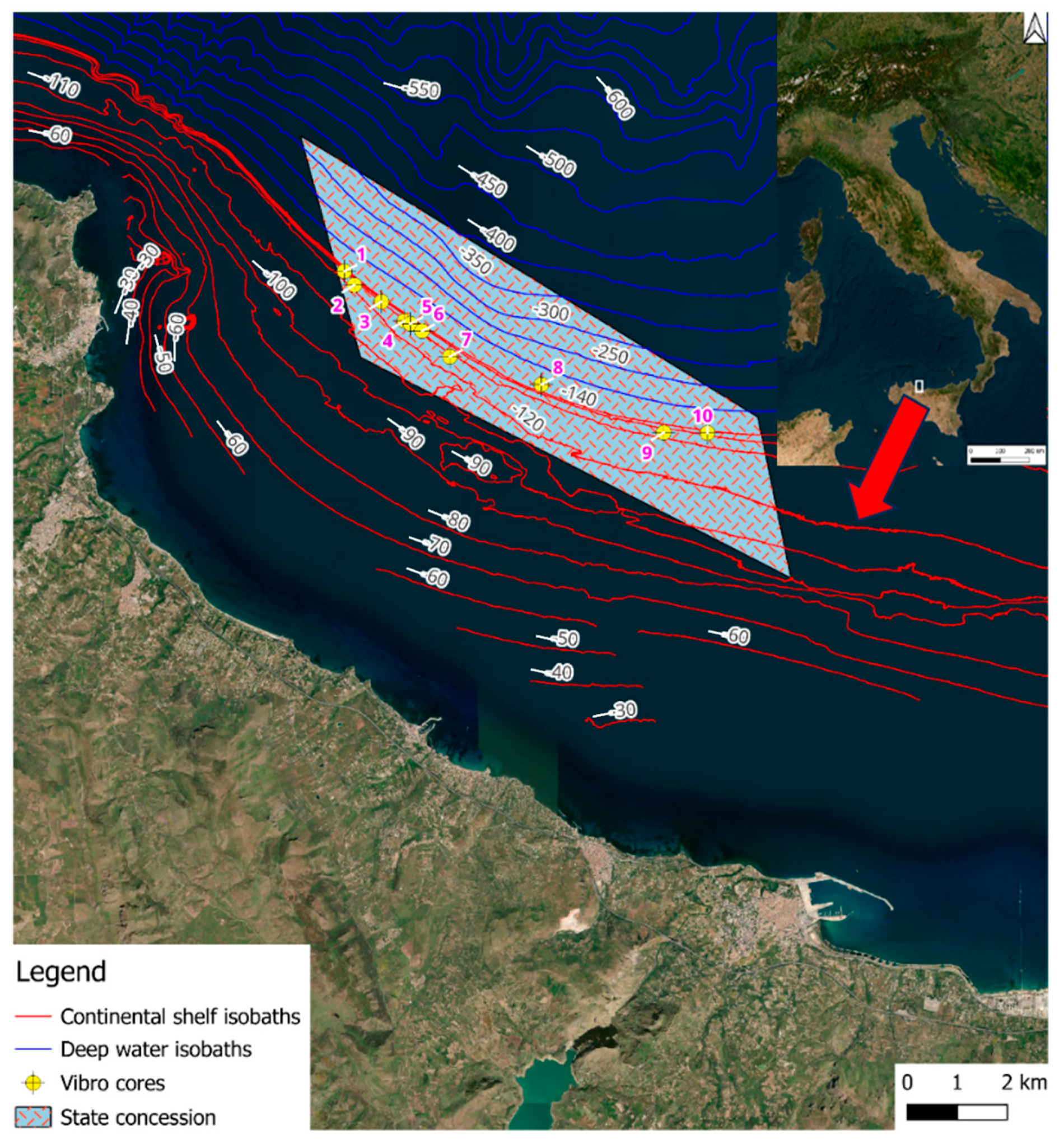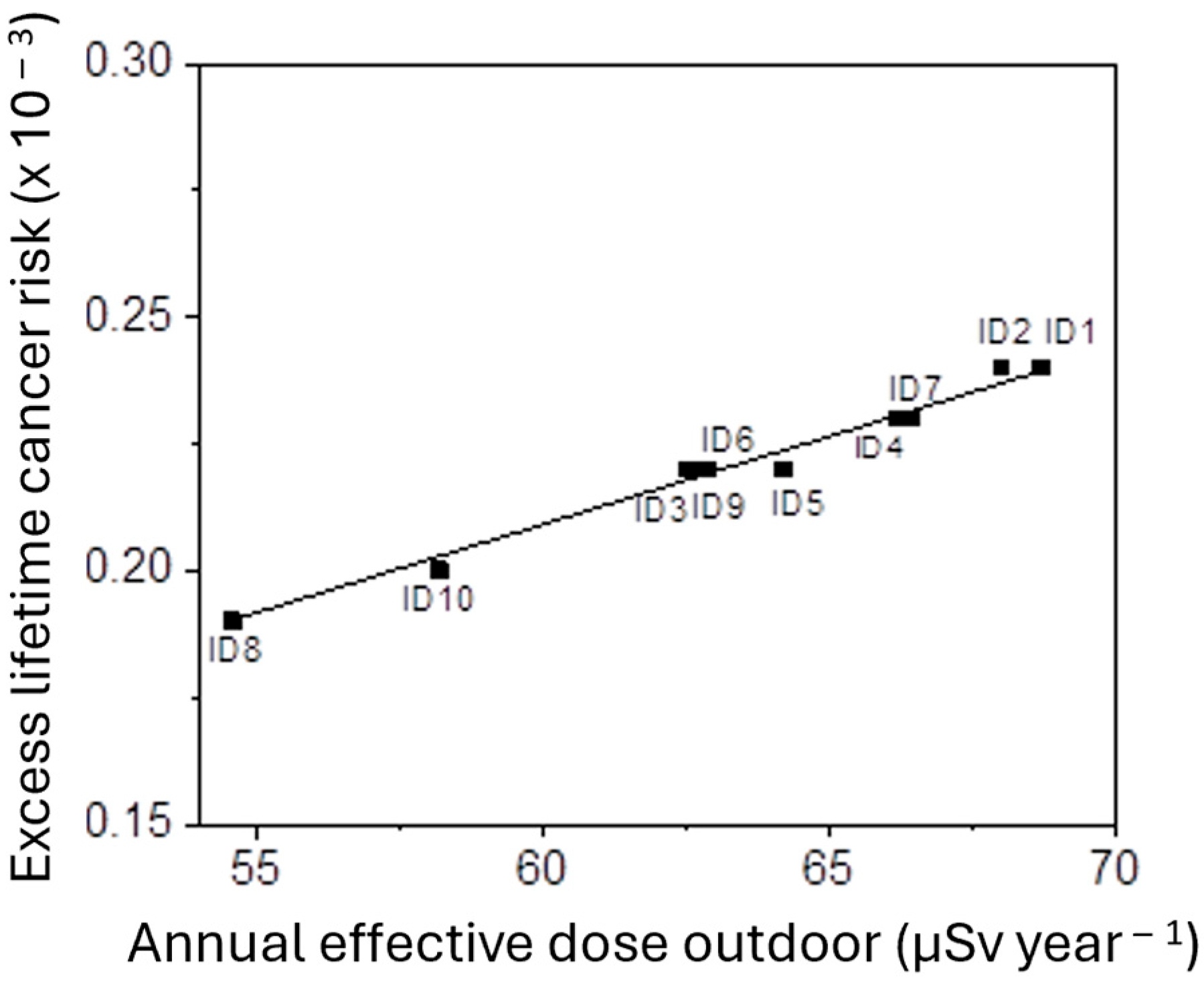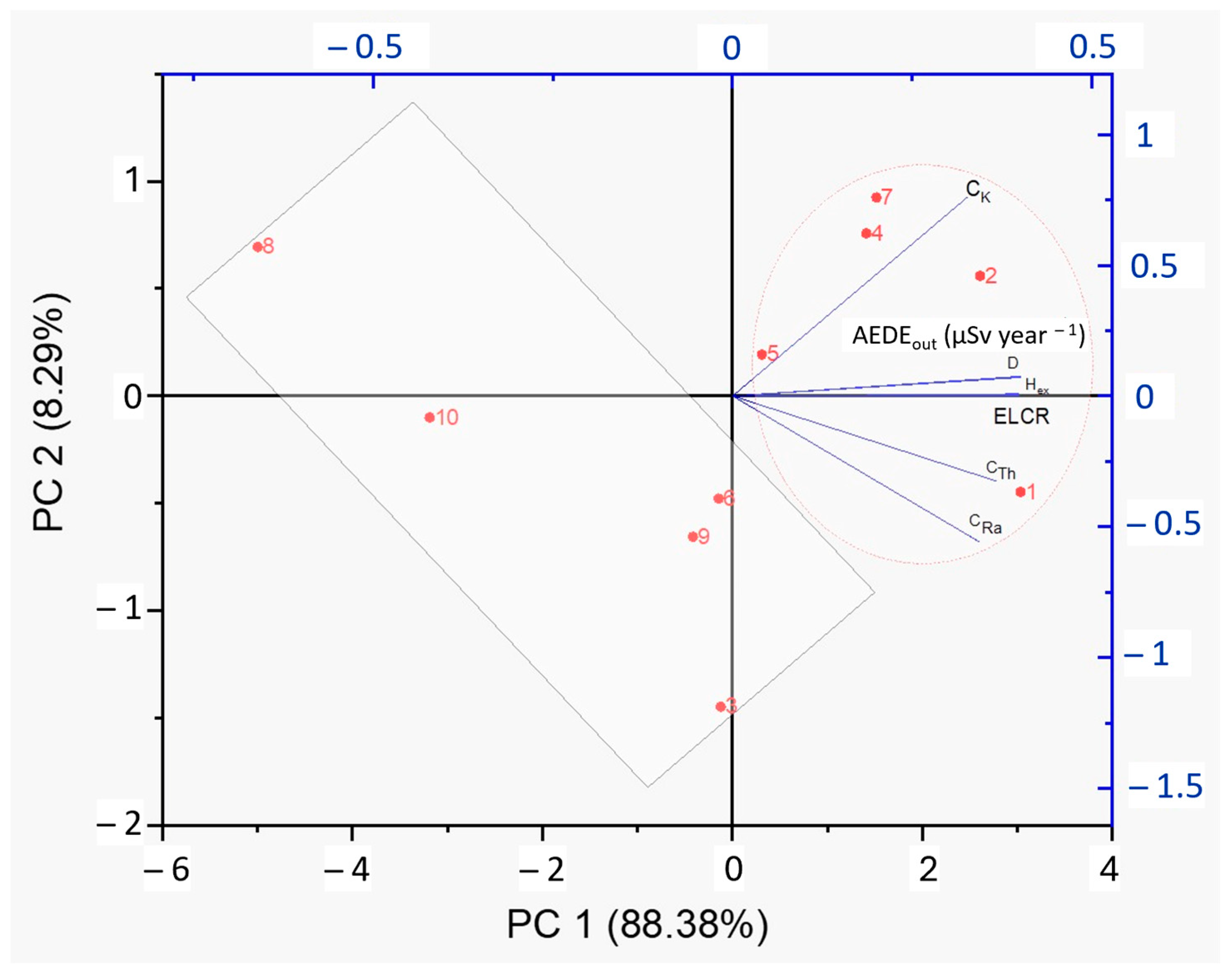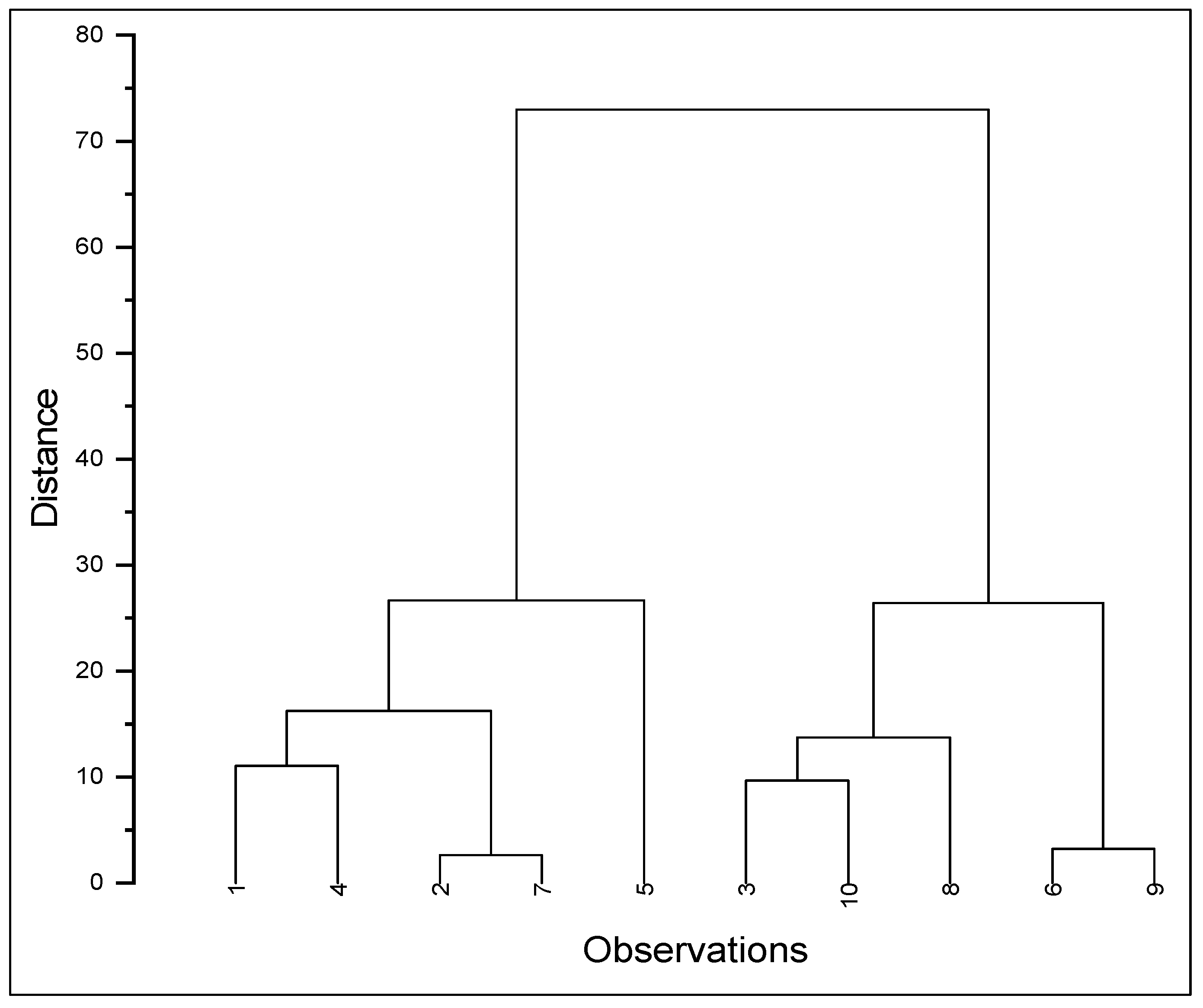Multivariate Statistics, Radioactivity and Radiological Hazard Evaluation in Marine Sediments of Selected Areas from Sicily, Southern Italy
Abstract
:1. Introduction
2. Materials and Methods
2.1. Sampling
2.2. HPGE Gamma Spectrometry Analysis
2.3. Evaluation of Radiological Hazard
2.3.1. Absorbed Gamma Dose Rate
2.3.2. Annual Effective Dose Equivalent Outdoor
2.3.3. External Hazard Index
2.3.4. Excess Lifetime Cancer Risk
2.4. Statistical Treatments
3. Results and Discussion
3.1. The Specific Activities of Detected Radioisotopes
3.2. Radiological Hazard Assessment
- (i)
- (ii)
- The annual effective dose equivalent outdoor was lower than the threshold limit of 1 mSv year−1 [36] in all cases;
- (iii)
- The external hazard index was lower than unity in all cases.
- (iv)
3.3. Statistical Features
4. Summary and Future Perspectives
Author Contributions
Funding
Data Availability Statement
Conflicts of Interest
References
- United Nations Scientific Committee on the Effects of Atomic Radiation. Sources and Effects of Ionizing Radiation: Report to the General Assembly, with Scientific Annexes; UN Publications: New York, NY, USA, 2000; Volume 1, ISBN 92-1-142238-8. [Google Scholar]
- Zhao, X.L.; Jiang, G.G.; Song, Z.L.; Touseef, B.; Zhao, X.Y.; Huang, Y.Y.; Guo, M.; Bharti, B. Concentrations of heavy metals in PM2.5 and health risk assessment around Chinese New Year in Dalian, China. Open Geosci. 2021, 13, 1366–1374. [Google Scholar] [CrossRef]
- Caridi, F.; D’Agostino, M.; Messina, M.; Marcianò, G.; Grioli, L.; Belvedere, A.; Marguccio, S.; Belmusto, G. Lichens as environmental risk detectors. Eur. Phys. J. Plus 2017, 132, 1–9. [Google Scholar] [CrossRef]
- Lambeck, K.; Bard, E. Sea-level change along the French Mediterranean coast for the past 30000 years. Earth Planet. Sci. Lett. 2000, 175, 203–222. [Google Scholar] [CrossRef]
- Rebecca, L. Climate Change: Global Sea Level. Available online: https://www.climate.gov/news-features/understanding-climate/climate-change-global-sea-level (accessed on 27 February 2025).
- Randazzo, G.; Lanza, S. Regional Plan against Coastal Erosion: A Conceptual Model for Sicily. Land 2020, 9, 307. [Google Scholar] [CrossRef]
- Caridi, F.; Messina, M.; Faggio, G.; Santangelo, S.; Messina, G.; Belmusto, G. Radioactivity, radiological risk and metal pollution assessment in marine sediments from Calabrian selected areas, Southern Italy. Eur. Phys. J. Plus 2018, 133, 65. [Google Scholar] [CrossRef]
- Fouskas, F.; Godelitsas, A.; Argyraki, A.; Pappa, F.K.; Tsabaris, C. Metal concentrations and radioactivity in sediments at the northern coastal zone of Ikaria Island, eastern Mediterranean, Greece. J. Radioanal. Nucl. Chem. 2018, 317, 55–68. [Google Scholar] [CrossRef]
- Guangshan, L.; Sumei, L.; Jing, Z.; Yipu, H.; Min, C. Sedimentary Processes of the Qingdao Nearshore Traced Using a Multi-radionuclide Approach. Water Air Soil Pollut.Focus 2007, 7, 693–701. [Google Scholar] [CrossRef]
- Miralles, J.; Radakovitch, O.; Aloisi, J.-C. 210Pb sedimentation rates from the Northwestern Mediterranean margin. Mar. Geol. 2005, 216, 155–167. [Google Scholar] [CrossRef]
- He, Q.; Walling, D.E. The distribution of fallout 137Cs and 210Pb in undisturbed and cultivated soils. Appl. Radiat. Isot. 1997, 48, 677–690. [Google Scholar] [CrossRef]
- Caridi, F.; Messina, M.; Belvedere, A.; D’Agostino, M.; Marguccio, S.; Settineri, L.; Belmusto, G. Food salt characterization in terms of radioactivity and metals contamination. Appl. Sci. 2019, 9, 2882. [Google Scholar] [CrossRef]
- Caridi, F.; Di Bella, M.; Sabatino, G.; Belmusto, G.; Fede, M.R.; Romano, D.; Italiano, F.; Mottese, A. Assessment of natural radioactivity and radiological risks in river sediments from calabria (Southern Italy). Appl. Sci. 2021, 11, 1729. [Google Scholar] [CrossRef]
- Zagorodnyuk, L.H.; Mestnikov, A.E.; Makhortov, D.S.; Akhmed, A.A.A. Mixed binders with the use of volcanic ash. Lect. Notes Civ. Eng. 2021, 95, 9–15. [Google Scholar] [CrossRef]
- Caridi, F.; Marguccio, S.; Durante, G.; Trozzo, R.; Fullone, F.; Belvedere, A.; D’Agostino, M.; Belmusto, G. Natural radioactivity measurements and dosimetric evaluations in soil samples with a high content of NORM. Eur. Phys. J. Plus 2017, 132, 56. [Google Scholar] [CrossRef]
- Pappa, F.K.; Tsabaris, C.; Ioannidou, A.; Patiris, D.L.; Kaberi, H.; Pashalidis, I.; Eleftheriou, G.; Androulakaki, E.G.; Vlastou, R. Radioactivity and metal concentrations in marine sediments associated with mining activities in Ierissos Gulf, North Aegean Sea, Greece. Appl. Radiat. Isot. 2016, 116, 22–33. [Google Scholar] [CrossRef] [PubMed]
- Delbono, I.; Barsanti, M.; Schirone, A.; Conte, F.; Delfanti, R. 210Pb mass accumulation rates in the depositional area of the Magra River (Mediterranean Sea, Italy). Cont. Shelf Res. 2016, 124, 35–48. [Google Scholar] [CrossRef]
- Androulakaki, E.G.; Tsabaris, C.; Eleftheriou, G.; Kokkoris, M.; Patiris, D.L.; Pappa, F.K.; Vlastou, R. Efficiency calibration for in situ γ-ray measurements on the seabed using Monte Carlo simulations: Application in two different marine environments. J. Environ. Radioact. 2016, 164, 47–59. [Google Scholar] [CrossRef]
- Pappa, F.K.; Tsabaris, C.; Patiris, D.L.; Androulakaki, E.G.; Eleftheriou, G.; Betsou, C.; Michalopoulou, V.; Kokkoris, M.; Vlastou, R. Historical trends and assessment of radionuclides and heavy metals in sediments near an abandoned mine, Lavrio, Greece. Environ. Sci. Pollut. Res. 2018, 25, 30084–30100. [Google Scholar] [CrossRef]
- Androulakaki, E.G.; Tsabaris, C.; Eleftheriou, G.; Kokkoris, M.; Patiris, D.L.; Vlastou, R. Seabed radioactivity based on in situ measurements and Monte Carlo simulations. Appl. Radiat. Isot. 2015, 101, 83–92. [Google Scholar] [CrossRef]
- Abbasi, A.; Mirekhtiary, F. 137Cs and 40K concentration ratios (CRs) in annual and perennial plants in the Caspian coast. Mar. Pollut. Bull. 2019, 146, 671–677. [Google Scholar] [CrossRef]
- Hurtado, S.; Jose, V.; Rivera-Silva, J.; Mas, J.L.; Aparicio, I.; Santos, J.; Alonso, E. Levels of radionuclide concentrations in benthic invertebrate species from the Balearic Islands, Western Mediterranean, during 2012–2018. Mar. Pollut. Bull. 2019, 149, 110519. [Google Scholar] [CrossRef]
- Dar, M.; El-Saharty, A. Some radioactive-elements in the coastal sediments of the Mediterranean Sea. Radiat. Prot. Dosimetry 2012, 153, 361–368. [Google Scholar] [CrossRef]
- European Commission. Directive 2008/105/EC of the European Parliament and of the Council of 16 December 2008 on environmental quality standards in the field of water policy, amending and subsequently repealing Council Directives 82/176. EEC 2008, 83, 84–97. Available online: https://eur-lex.europa.eu/legal-content/EN/TXT/PDF/?uri=CELEX:02008L0105-20130913 (accessed on 26 February 2025).
- García-Talavera, M.; Matarranz, J.L.M.; Salas, R.; Ramos, L. A regulatory perspective on the radiological impact of NORM industries: The case of the Spanish phosphate industry. J. Environ. Radioact. 2011, 102, 1–7. [Google Scholar] [CrossRef]
- Giorgia Potortì, A.; Francesco Mottese, A.; Rita Fede, M.; Sabatino, G.; Dugo, G.; Lo Turco, V.; Costa, R.; Caridi, F.; Di Bella, M.; Di Bella, G. Multielement and chemometric analysis for the traceability of the Pachino Protected Geographical Indication (PGI) cherry tomatoes. Food Chem. 2022, 386, 132746. [Google Scholar] [CrossRef]
- Mottese, A.F.; Sabatino, G.; Di Bella, M.; Fede, M.R.; Parisi, F.; Marcianò, G.; Tripodo, A.; Italiano, F.; Dugo, G.; Caridi, F. Contribution of soil compositions, harvested times and varieties on chemical fingerprint of Italian and Turkish citrus cultivars. Int. J. Food Sci. Technol. 2021, 56, 2628–2639. [Google Scholar] [CrossRef]
- Amaral, P.G.Q.; Galembeck, T.M.B.; Bonotto, D.M.; Artur, A.C. Uranium distribution and radon exhalation from Brazilian dimension stones. Appl. Radiat. Isot. 2012, 70, 808–817. [Google Scholar] [CrossRef]
- Eleftheriou, G.; Tsabaris, C.; Androulakaki, E.G.; Pappa, F.K.; Patiris, D.L. High resolution gamma-ray spectrometry for routine measurements of environmental samples. Appl. Radiat. Isot. 2024, 206, 111234. [Google Scholar] [CrossRef] [PubMed]
- Papadopoulos, A.; Christofides, G.; Koroneos, A.; Stoulos, S. Natural radioactivity distribution and gamma radiation exposure of beach sands from Sithonia Peninsula. Open Geosci. 2014, 6, 229–242. [Google Scholar] [CrossRef]
- Stoulos, S.; Manolopoulou, M.; Papastefanou, C. Assessment of natural radiation exposure and radon exhalation from building materials in Greece. J. Environ. Radioact. 2003, 69, 225–240. [Google Scholar] [CrossRef]
- ACCREDIA. Available online: https://www.accredia.it (accessed on 25 February 2025).
- Nachar, N. The Mann-Whitney U: A Test for Assessing Whether Two Independent Samples Come from the Same Distribution. Tutor. Quant. Methods Psychol. 2008, 4, 13–20. [Google Scholar] [CrossRef]
- EC (European Commission). EC Radiation Protection 112: Radiological Protection Principles Concerning the Natural Radioactivity of Building Materials; European Commission: Brussels, Belgium, 1999; pp. 1–16. [Google Scholar]
- Righi, S.; Bruzzi, L. Natural radioactivity and radon exhalation in building materials used in Italian dwellings. J. Environ. Radioact. 2006, 88, 158–170. [Google Scholar] [CrossRef] [PubMed]
- Legislation Italian D.Lgs. 101/20. 2020. Available online: https://www.gazzettaufficiale.it/eli/id/2020/08/12/20G00121/sg (accessed on 25 February 2025).
- Beretka, J.; Matthew, P.J. Natural radioactivity of Australian building materials, industrial wastes and by-products. Health Phys. 1985, 48, 87–95. [Google Scholar] [CrossRef] [PubMed]
- Avwiri, G.O.; Egieya, J.M. Radiometric assay of hazard indices and excess lifetime cancer risk due to natural radioactivity in soil profile in Ogba/Egbema/Ndoni local government area of Rivers state, Nigeria. Acad. Res. Int. 2013, 4, 54–65. [Google Scholar]
- Taskin, H.; Karavus, M.; Ay, P.; Topuzoglu, A.; Hidiroglu, S.; Karahan, G. Radionuclide concentrations in soil and lifetime cancer risk due to gamma radioactivity in Kirklareli, Turkey. J. Environ. Radioact. 2009, 100, 49–53. [Google Scholar] [CrossRef]
- Seifert, E. Origin Pro 9.1: Scientific Data Analysis and Graphing Software-Software Review. J. Chem. Inf. Model. 2014, 54, 1552. [Google Scholar] [CrossRef] [PubMed]
- Greenacre, M.; Groenen, P.J.F.; Hastie, T.; D’Enza, A.I.; Markos, A.; Tuzhilina, E. Principal component analysis. Nat. Rev. Methods Prim. 2022, 2, 100. [Google Scholar] [CrossRef]
- Shahrokhi, A.; Adelikhah, M.; Chalupnik, S.; Kovács, T. Multivariate statistical approach on distribution of natural and anthropogenic radionuclides and associated radiation indices along the north-western coastline of Aegean Sea, Greece. Mar. Pollut. Bull. 2021, 163, 112009. [Google Scholar] [CrossRef]
- Bernard, K.; Munasinghe, S. The Influence Of Facebook Marketing On Consumer Buying Intention Of Clothing: Evidence From Young Adults. Arch. Bus. Res. 2020, 8, 37–51. [Google Scholar] [CrossRef]
- Li, B.; Lima, M.; Nie, Y.; Xu, L.; Liu, X.; Yuan, H.; Chen, C.; Dias, A.; Zhang, X.Y. HPLC-DAD Fingerprints Combined With Multivariate Analysis of Epimedii Folium From Major Producing Areas in Eastern Asia: Effect of Geographical Origin and Species. Front. Pharmacol. 2021, 12, 761551. [Google Scholar] [CrossRef]
- Aközcan, S.; Mancini, S.; Özden, S.; Venuti, V.; Caridi, F.; Paladini, G.; Guida, M. Comparison of Radioactivity and Metal Pollution Concentrations in Marine Sediment Samples Obtained from the Aegean Sea (Turkey) and the Calabria Region (Italy). WSEAS Trans. Environ. Dev. 2023, 19, 591–596. [Google Scholar] [CrossRef]
- Ahmedai, M.A.; Ahmed, S.A.; Ahmed, Y.H.; Ibrahiem, E.S.M. Tagabo Volcanic Ash as Cement Replacing Materials. FES J. Eng. Sci. 2021, 9, 35–39. [Google Scholar] [CrossRef]
- Gruber, V.; Bossew, P.; De Cort, M.; Tollefsen, T. The European map of the geogenic radon potential. J. Radiol. Prot. 2013, 33, 51. [Google Scholar] [CrossRef]
- Banerjee, K.S.; Basu, A.; Guin, R.; Sengupta, D. Radon (222Rn) level variations on a regional scale from the Singhbhum Shear Zone, India: A comparative evaluation between influence of basement U-activity and porosity. Radiat. Phys. Chem. 2011, 80, 614–619. [Google Scholar] [CrossRef]
- Girault, F.; Gajurel, A.P.; Perrier, F.; Upreti, B.N.; Richon, P. Radon emanation of heterogeneous basin deposits in Kathmandu Valley, Nepal. J. Asian Earth Sci. 2011, 40, 595–610. [Google Scholar] [CrossRef]
- Wiśniewski, Z. MP estimation applied to platykurtic sets of geodetic observations. Geod. Cartogr. 2017, 66, 117–135. [Google Scholar] [CrossRef]
- Caridi, F.; Paladini, G.; Marguccio, S.; Belvedere, A.; D’Agostino, M.; Messina, M.; Crupi, V.; Venuti, V.; Majolino, D. Evaluation of Radioactivity and Heavy Metals Content in a Basalt Aggregate for Concrete from Sicily, Southern Italy: A Case Study. Appl. Sci. 2023, 13, 4804. [Google Scholar] [CrossRef]
- Turekian, K.K.; Haven, N.; Hans, K.; Universitat, W.M. Der Distribution of the Elements in Some Major Units of the Earth’s Crust. Geol. Soc. Am. Bull. 1961, 72, 175–192. [Google Scholar] [CrossRef]
- Qureshi, A.A.; Tariq, S.; Din, K.U.; Manzoor, S.; Calligaris, C.; Waheed, A. Evaluation of excessive lifetime cancer risk due to natural radioactivity in the rivers sediments of Northern Pakistan. J. Radiat. Res. Appl. Sci. 2014, 7, 438–447. [Google Scholar] [CrossRef]
- Vaasma, T. Grain-size analysis of lacustrine sediments: A comparison of pre-treatment methods. Est. J. Ecol. 2008, 57, 231–243. [Google Scholar] [CrossRef]
- Li, Y.-H.; Schoonmaker, J. Chemical Composition and Mineralogy of Marine Sediments. Treatise Geochem. 2003, 7, 1–35. [Google Scholar] [CrossRef]
- Mohd Razali, N.; Yap, B. Power Comparisons of some selected normality tests. Proc. Reg. Conf. Stat. Sci. 2010, 2, 126–138. [Google Scholar]
- Zhao, M.; Zheng, Y.-F. The intensity of chemical weathering: Geochemical constraints from marine detrital sediments of Triassic age in South China. Chem. Geol. 2015, 391, 111–122. [Google Scholar] [CrossRef]
- Wentworth, C.K. A Scale of Grade and Class Terms for Clastic Sediments. J. Geol. 1922, 30, 377–392. [Google Scholar] [CrossRef]
- Hedges, J.I.; Keil, R.G. Sedimentary organic matter preservation: An assessment and speculative synthesis. Mar. Chem. 1995, 49, 81–115. [Google Scholar] [CrossRef]
- Schwartz, W.R.A. Berner, Early Diagenesis, A Theoretical Approach. XII + 241 S., 17 Tab., 60 Abb. Princeton, N.Y. 1980. Princeton University Press. $ 31.50 (Cloth), $ 13.00 (Paperb.). Z. Allg. Mikrobiol. 1981, 21, 765. [Google Scholar] [CrossRef]
- McCann, S.B. Book reviews: Komar, P.D. 1976: Beach processes and sedimentation. New Jersey: Prentice Hall. xvii+429 pp. Prog. Phys. Geogr. Earth Environ. 1978, 2, 176. [Google Scholar] [CrossRef]





| Site ID | GPS Position (Reference System WGS84/UTM Zone 33 N EPSG: 32633) | Sampling Depth (m) | |
|---|---|---|---|
| Latitude | Longitude | ||
| 1 | 376901 | 4217704 | 121 |
| 2 | 377100 | 4217430 | 121 |
| 3 | 377642 | 4217097 | 128 |
| 4 | 378101 | 4216713 | 126 |
| 5 | 378217 | 4216657 | 128 |
| 6 | 378453 | 4216513 | 128 |
| 7 | 379008 | 4215999 | 124 |
| 8 | 380841 | 4215441 | 129 |
| 9 | 383289 | 4214482 | 131 |
| 10 | 384164 | 4214475 | 137 |
| GMX Detector | |
|---|---|
| Parameter | Value |
| FWHM | 1.94 keV |
| Peak/Compton | 65:1 |
| εr | 37.5% (at the 1.33 MeV 60Co γ–line) |
| ΔV | −4800 V |
| ΔE | 5 keV–2 MeV |
| Site ID | CRa (Bq kg−1 d.w.) | CTh (Bq kg−1 d.w.) | CK (Bq kg−1 d.w.) | CCs (Bq kg−1 d.w.) |
|---|---|---|---|---|
| 1 | 22.4 ± 3.2 | 41.1 ± 6.3 | 500 ± 71 | <0.10 |
| 2 | 20.7 ± 4.9 | 40.1 ± 9.7 | 522 ± 122 | <0.12 |
| 3 | 21.4 ± 3.4 | 38.6 ± 8.2 | 426 ± 101 | <0.09 |
| 4 | 19.4 ± 4.6 | 39.3 ± 9.5 | 510 ± 120 | <0.13 |
| 5 | 20.4 ± 4.8 | 37.4 ± 9.1 | 487 ± 114 | <0.11 |
| 6 | 19.8 ± 2.3 | 38.6 ± 4.9 | 452 ± 51 | <0.09 |
| 7 | 19.9 ± 4.7 | 38.5 ± 9.4 | 521 ± 119 | <0.08 |
| 8 | 16.5 ± 3.9 | 31.4 ± 4.5 | 431 ± 75 | <0.10 |
| 9 | 20.5 ± 2.9 | 37.8 ± 5.8 | 449 ± 64 | <0.10 |
| 10 | 16.6 ± 4.4 | 36.9 ± 5.1 | 420 ± 72 | <0.09 |
| Statistically Function | CRa | CTh | CK |
|---|---|---|---|
| Min | 16.5 | 31.4 | 420 |
| Max | 22.4 | 41.1 | 521 |
| Mean | 19.76 | 37.96 | 471.7 |
| Geometric mean | 19.76 | 38.50 | 475.58 |
| Median | 20.4 | 38.51 | 493.5 |
| Standard deviation | 1.89 | 2.61 | 40.39 |
| Skewness | −0.67 | 0.51 | −0.24 |
| Kurtosis | −0.86 | −1.00 | −1.96 |
| Site ID | D (nGy h−1) | AEDEout (µSv year−1) | Hex | ELCR (×10−3) |
|---|---|---|---|---|
| 1 | 56.0 | 68.7 | 0.32 | 0.24 |
| 2 | 55.4 | 68.0 | 0.32 | 0.24 |
| 3 | 51.1 | 62.5 | 0.30 | 0.22 |
| 4 | 54.0 | 66.2 | 0.31 | 0.23 |
| 5 | 52.3 | 64.2 | 0.30 | 0.22 |
| 6 | 51.3 | 62.9 | 0.30 | 0.22 |
| 7 | 54.2 | 66.4 | 0.31 | 0.23 |
| 8 | 44.6 | 54.6 | 0.26 | 0.19 |
| 9 | 51.0 | 62.6 | 0.29 | 0.22 |
| 10 | 47.5 | 58.2 | 0.27 | 0.20 |
| Average | 51.7 | 63.4 | 0.30 | 0.22 |
| Variables | p-Value | ||
|---|---|---|---|
| Shapiro–Wilk | Anderson–Darling | Lilliefors | |
| CRa | 0.547 | 0.583 | 0.529 |
| CTh | 0.088 | 0.289 | 0.186 |
| CK | 0.224 | 0.455 | 0.386 |
| Variables | CRa | CTh | CK | D | AEDEout | Hex | ELCR |
|---|---|---|---|---|---|---|---|
| CRa | 1 | 0.789 | 0.475 | 0.821 | 0.820 | 0.847 | 0.847 |
| CTh | 0.789 | 1 | 0.571 | 0.907 | 0.906 | 0.894 | 0.907 |
| CK | 0.475 | 0.571 | 1 | 0.839 | 0.841 | 0.806 | 0.807 |
| D | 0.821 | 0.907 | 0.839 | 1 | 0.999 | 0.986 | 0.991 |
| AEDEout | 0.820 | 0.906 | 0.841 | 0.999 | 1 | 0.984 | 0.991 |
| Hex | 0.847 | 0.894 | 0.806 | 0.986 | 0.984 | 1 | 0.987 |
| ELCR | 0.847 | 0.907 | 0.807 | 0.991 | 0.991 | 0.987 | 1 |
| PC1 | PC2 | PC3 | PC4 | PC5 | |
|---|---|---|---|---|---|
| Eigenvalues | 6.18 | 0.58 | 0.20 | 0.02 | 0.009 |
| Variability | 88.38 | 8.29 | 2.91 | 0.29 | 0.14 |
| % Total Variance Explained | 88.38 | 96.67 | 99.57 | 99.86 | 100 |
Disclaimer/Publisher’s Note: The statements, opinions and data contained in all publications are solely those of the individual author(s) and contributor(s) and not of MDPI and/or the editor(s). MDPI and/or the editor(s) disclaim responsibility for any injury to people or property resulting from any ideas, methods, instructions or products referred to in the content. |
© 2025 by the authors. Licensee MDPI, Basel, Switzerland. This article is an open access article distributed under the terms and conditions of the Creative Commons Attribution (CC BY) license (https://creativecommons.org/licenses/by/4.0/).
Share and Cite
Caridi, F.; Mottese, A.F.; Paladini, G.; Pistorino, L.; Gregorio, F.; Lanza, S.; Randazzo, G.; Marguccio, S.; Belvedere, A.; D’Agostino, M.; et al. Multivariate Statistics, Radioactivity and Radiological Hazard Evaluation in Marine Sediments of Selected Areas from Sicily, Southern Italy. J. Mar. Sci. Eng. 2025, 13, 769. https://doi.org/10.3390/jmse13040769
Caridi F, Mottese AF, Paladini G, Pistorino L, Gregorio F, Lanza S, Randazzo G, Marguccio S, Belvedere A, D’Agostino M, et al. Multivariate Statistics, Radioactivity and Radiological Hazard Evaluation in Marine Sediments of Selected Areas from Sicily, Southern Italy. Journal of Marine Science and Engineering. 2025; 13(4):769. https://doi.org/10.3390/jmse13040769
Chicago/Turabian StyleCaridi, Francesco, Antonio Francesco Mottese, Giuseppe Paladini, Lorenzo Pistorino, Francesco Gregorio, Stefania Lanza, Giovanni Randazzo, Santina Marguccio, Alberto Belvedere, Maurizio D’Agostino, and et al. 2025. "Multivariate Statistics, Radioactivity and Radiological Hazard Evaluation in Marine Sediments of Selected Areas from Sicily, Southern Italy" Journal of Marine Science and Engineering 13, no. 4: 769. https://doi.org/10.3390/jmse13040769
APA StyleCaridi, F., Mottese, A. F., Paladini, G., Pistorino, L., Gregorio, F., Lanza, S., Randazzo, G., Marguccio, S., Belvedere, A., D’Agostino, M., Majolino, D., & Venuti, V. (2025). Multivariate Statistics, Radioactivity and Radiological Hazard Evaluation in Marine Sediments of Selected Areas from Sicily, Southern Italy. Journal of Marine Science and Engineering, 13(4), 769. https://doi.org/10.3390/jmse13040769













